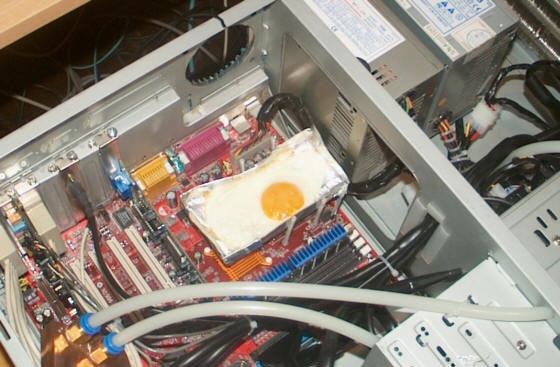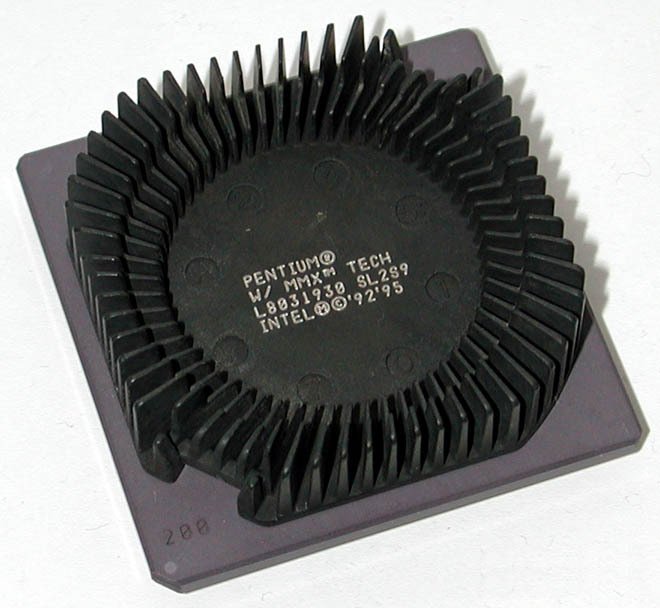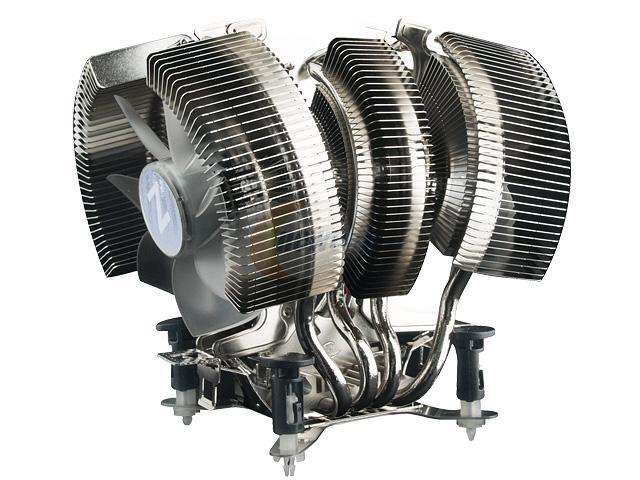TDP - Thermal Design Power
Those who are familiar with the Landauer principle are aware that during irreversible calculations, heat is no less than k * T * ln2, and those versed in electronics will confirm that this value is actually orders of magnitude more due to the presence of through current when switching CMOS pairs, parasitic leakage currents and resistance of metallic interconnects. As for ordinary users, they are simply accustomed to the fact that processors heat up during work and emit heat.

So, get acquainted - TDP. As can be seen from the title, TDP stands for "Thermal Design Power". This value indicates the maximum amount of heat that the chip cooling system should dissipate.
Manufacturers take it equal to the maximum power consumed by the chip. Power consumption is easier to measure, and in the end all of it (with the exception of negligible electromagnetic radiation) will be dissipated as heat.
The table below shows the TDP values for the iconic (in my opinion) Intel desktop processor models.
According to the logic of things, while reducing the topological norms, the heat release should decrease. However, the number of transistors per crystal grew much faster than the heat release of a separate CMOS pair decreased. This was the cause of the pattern, which is well traced in the table. The infamous gigahertz race led to the fact that the Pentium 4 set a kind of anti-record, in its 3.8 GHz modification exceeding 100 W over TDP. Obviously, it was impossible to put up with such a situation: the computer looked more and more like a time bomb. And the conclusions were made - the heat has declined.
And do not be confused by the large TDP of top-end processors like the Core i7-3930K. These are very special members of the processor family and those who are willing to pay a tidy sum for them will surely take care of the appropriate cooling. In general, the TDP of Intel processors has recently significantly decreased and continues to decline.
')
Already in the era of the first Pentium processor, computers began to use active cooling, which was a ridiculous radiator and the same “propeller”.

pictured Intel Pentium 200 MMX with fan removed
It was possible to get by with passive cooling, using a slightly more developed radiator, but in those times they didn’t care too much about noiselessness. Of course, the case was not limited to a single CPU cooler, the hard drives and power supplies made a significant contribution to the overall system noise.
Cooling systems developed smoothly in parallel with the increase in heat generation of processors and finally ...

In the era of Pentium 4 processors, monstrous coolers and alternative cooling methods were developed: liquid, cryogenic, and nitrogen. For those interested in history, I will provide a link to the article “Coolers of the Millennium” by the authorship of a friend LIKE OFF from 2001.
Nowadays, low noise for a PC is of great importance; many enthusiasts are trying to assemble a computer as silent as possible, ideally with fully passive cooling.
It is quite possible task. In such cases, most often use a processor with a TDP of not more than 40W. You can choose a model with a large TDP and lower its frequency and voltage on the core. (Power is proportional to the frequency and square of the supply voltage).
As a result, something like this might turn out:

With a TDP greater than 50W, it is already difficult to do without active cooling. Even if the processor cooling is passive, you need good air circulation inside the case.
Those whose acquaintance with computers began a long time ago probably had a legendary video from the team of Tom's Hardware. (I cannot give a link to it for ideological reasons). These guys figured out what will happen to the processor if it loses the cooling system during operation. The situation is actually quite possible: the cooler may fall off during transport, or the fan may break in the cooling system. Finally, the most common problem is when the thermal interface between the processor and the cooling system loses its heat-conducting properties over time.
What happens when the processor temperature exceeds the limit? Obviously, nothing good, but the processor still has some self-defense. Starting with Pentium 4, when the temperature reaches about 90 ° C, the so-called throttling turns on: the processor will begin to skip cycles, slowing down its work and reducing heat generation. Of course, left without cooling, the processor will not be able to provide even a little bit of acceptable performance.
For laptops, the main aspect of TDP is power consumption, because it has a direct impact on battery life. TDP Atom processors, most often used in netbooks, are in the range of 2-10W, and most notebook processors - 15-40W.
According to my estimates, based on network research, a 15 "laptop with discrete graphics and a processor with a TDP 35W consumes around 80W in total. You can estimate the processor's contribution to the total power consumption of a laptop as 30-40%. Of course, this is true only with maximum processor load Most of the time, the processor rests, energy-saving technologies come into play, and its share in the total power consumption decreases.
Note that despite the low TDP of mobile processors, it is sometimes problematic to implement effective cooling inside a tight case, so overheating occurs in notebooks even more often than in desktops.
In general, I talked about TDP. This topic can be developed in two directions: consider the causes of power consumption of CMOS circuits, which include processors, and talk about energy-saving technologies used in modern Intel processors. I propose to vote for one of my comments on this article: "Energy-saving technologies" and "Energy consumption in CMOS circuits."
Those who get more votes will determine the next topic. Also in the comments real stories about the fight with the temperature inside the computer, victories and defeats in it are highly appreciated.

So, get acquainted - TDP. As can be seen from the title, TDP stands for "Thermal Design Power". This value indicates the maximum amount of heat that the chip cooling system should dissipate.
Manufacturers take it equal to the maximum power consumed by the chip. Power consumption is easier to measure, and in the end all of it (with the exception of negligible electromagnetic radiation) will be dissipated as heat.
The history of desktop processors in the context of TDP
The table below shows the TDP values for the iconic (in my opinion) Intel desktop processor models.
| Model | Frequency | Tdp |
| Pentium | 75 MHz | 8.0 W |
| Pentium MMX | 200 MHz | 15.7 W |
| Pentium II 300 (0.35µ) | 300 MHz | 18.6 W |
| Pentium III 600 (0.25µ) | 600 MHz | 43 W |
| Pentium III 1000 (0.18µ) | 1GHz | 35.5W |
| Pentium III 1333 (0.13µ) | 1.33GHz | 34W |
| Pentium 4 1.5 (0.18µ) | 1.5GHz | 58W |
| Pentium 4 2.8 (0.13µ) | 2.8GHz | 68W |
| Pentium 4 HT 672 (90nm) | 3.8GHz | 115W |
| Pentium D 960 (65nm) | 3.6GHz @ 2 cores | 130 W |
| Core 2 Duo E6850 (65nm) | 3GHz @ 2 cores | 65W |
| Core 2 Quad Q6600 (65nm) | 2.4GHz @ 4 cores | 95W |
| Core 2 Quad Q9550S (45nm) | 2.83GHz @ 4 cores | 65W |
| Core i5-680 (32nm) | 3.6GHz @ 2 cores | 73W |
| Core i7-3930K (32nm) | 3.6 GHz @ 6 cores | 130 W |
| Core i7-3770K (22nm) | 3.5GHz-3.9GHz @ 4 Cores | 77W |
According to the logic of things, while reducing the topological norms, the heat release should decrease. However, the number of transistors per crystal grew much faster than the heat release of a separate CMOS pair decreased. This was the cause of the pattern, which is well traced in the table. The infamous gigahertz race led to the fact that the Pentium 4 set a kind of anti-record, in its 3.8 GHz modification exceeding 100 W over TDP. Obviously, it was impossible to put up with such a situation: the computer looked more and more like a time bomb. And the conclusions were made - the heat has declined.
And do not be confused by the large TDP of top-end processors like the Core i7-3930K. These are very special members of the processor family and those who are willing to pay a tidy sum for them will surely take care of the appropriate cooling. In general, the TDP of Intel processors has recently significantly decreased and continues to decline.
')
A small excursion into the history of cooling systems
Already in the era of the first Pentium processor, computers began to use active cooling, which was a ridiculous radiator and the same “propeller”.

pictured Intel Pentium 200 MMX with fan removed
It was possible to get by with passive cooling, using a slightly more developed radiator, but in those times they didn’t care too much about noiselessness. Of course, the case was not limited to a single CPU cooler, the hard drives and power supplies made a significant contribution to the overall system noise.
Cooling systems developed smoothly in parallel with the increase in heat generation of processors and finally ...

In the era of Pentium 4 processors, monstrous coolers and alternative cooling methods were developed: liquid, cryogenic, and nitrogen. For those interested in history, I will provide a link to the article “Coolers of the Millennium” by the authorship of a friend LIKE OFF from 2001.
Nowadays, low noise for a PC is of great importance; many enthusiasts are trying to assemble a computer as silent as possible, ideally with fully passive cooling.
It is quite possible task. In such cases, most often use a processor with a TDP of not more than 40W. You can choose a model with a large TDP and lower its frequency and voltage on the core. (Power is proportional to the frequency and square of the supply voltage).
As a result, something like this might turn out:

With a TDP greater than 50W, it is already difficult to do without active cooling. Even if the processor cooling is passive, you need good air circulation inside the case.
CPU overheating behavior
Those whose acquaintance with computers began a long time ago probably had a legendary video from the team of Tom's Hardware. (I cannot give a link to it for ideological reasons). These guys figured out what will happen to the processor if it loses the cooling system during operation. The situation is actually quite possible: the cooler may fall off during transport, or the fan may break in the cooling system. Finally, the most common problem is when the thermal interface between the processor and the cooling system loses its heat-conducting properties over time.
What happens when the processor temperature exceeds the limit? Obviously, nothing good, but the processor still has some self-defense. Starting with Pentium 4, when the temperature reaches about 90 ° C, the so-called throttling turns on: the processor will begin to skip cycles, slowing down its work and reducing heat generation. Of course, left without cooling, the processor will not be able to provide even a little bit of acceptable performance.
Mobile computing.
For laptops, the main aspect of TDP is power consumption, because it has a direct impact on battery life. TDP Atom processors, most often used in netbooks, are in the range of 2-10W, and most notebook processors - 15-40W.
According to my estimates, based on network research, a 15 "laptop with discrete graphics and a processor with a TDP 35W consumes around 80W in total. You can estimate the processor's contribution to the total power consumption of a laptop as 30-40%. Of course, this is true only with maximum processor load Most of the time, the processor rests, energy-saving technologies come into play, and its share in the total power consumption decreases.
Note that despite the low TDP of mobile processors, it is sometimes problematic to implement effective cooling inside a tight case, so overheating occurs in notebooks even more often than in desktops.
Conclusion
In general, I talked about TDP. This topic can be developed in two directions: consider the causes of power consumption of CMOS circuits, which include processors, and talk about energy-saving technologies used in modern Intel processors. I propose to vote for one of my comments on this article: "Energy-saving technologies" and "Energy consumption in CMOS circuits."
Those who get more votes will determine the next topic. Also in the comments real stories about the fight with the temperature inside the computer, victories and defeats in it are highly appreciated.
Source: https://habr.com/ru/post/148259/
All Articles